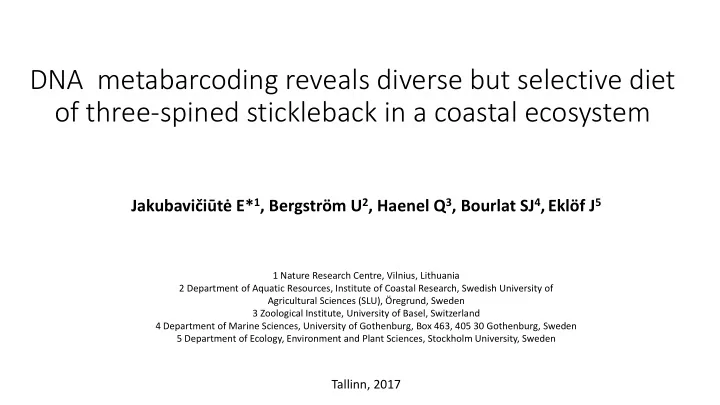

DNA metabarcoding reveals diverse but selective diet of three-spined stickleback in a coastal ecosystem Jakubavičiūtė E* 1 , Bergström U 2 , Haenel Q 3 , Bourlat SJ 4 , Eklöf J 5 1 Nature Research Centre, Vilnius, Lithuania 2 Department of Aquatic Resources, Institute of Coastal Research, Swedish University of Agricultural Sciences (SLU), Öregrund, Sweden 3 Zoological Institute, University of Basel, Switzerland 4 Department of Marine Sciences, University of Gothenburg, Box 463, 405 30 Gothenburg, Sweden 5 Department of Ecology, Environment and Plant Sciences, Stockholm University, Sweden Tallinn, 2017
Outline • Introduction: DNA metabarcoding • Stickleback diet diversity • Stickleback diet selectivity • Comparing the methods: visual stomach content analysis vs DNA metabarcoding 2
DNA metabarcoding • DNA barcode - any DNA sequence used for identification at any taxonomic level; • DNA barcoding - taxon identification using a standardized DNA region; • DNA metabarcoding - the use of NGS to identify multiple species in a sample using DNA barcodes; • OTU – operational taxonomic unit - gene sequence reads, clustered based on sequence similarity. 3 Kress et al., 2015
DNA metabarcoding • Biodiversity assesment, trophic interactions, community composition... • Environmental DNA (eDNA) metabarcoding • eDNA in aquatic environments - non-invasive monitoring tool 4
Material & Methods • 196 three-spined stickleback samples TL=57.7 ±7.6 mm (SD) • Visual inspection of stomach contents • DNA metabarcoding • Zooplankton abundance data in bays • Benthos abundance data in bays 5
Workflow Fish dissection, visual DNA extraction PCR identification of stomach • Amplification of 313 bp region contents in COI (Leray et al., 2013) • Universal and blocking primers Sequencing Taxonomic assignement Taxa1 (OTU).... # of reads • Sequences clustered into OTUs • Illumina MiSeq platform, final Taxa2 (OTU).... # of reads and compared against dataset of 10 586 546 reads reference databases 6
Data analysis • %N bar - proportions of prey in the stomachs based on the number of OTU reads per taxon • %F vis and %F bar - frequency of occurrence based on barcoding and visual data • Jacobs’s index for diet selectivity estimations • J =(r−p)/(r+p− 2pr) • r - %OTU reads of certain prey species in stomach (%N bar ) • p - proportion of certain prey in the environment (zooplankton/ benthos) J [-1;1] 7
Diet diversity of three-spined stickleback • 120 taxa revealed by metabarcoding in the stomachs of sticklebacks • 15 phyla • 27 classes • 52 orders • 66 families • 83 genus • 84 species • Primary prey – 103 taxa 8
Proportion of different classes in stomachs (%N bar ) Actinopterygii Bivalvia Gastropoda Polychaeta 2% 1% 1% 1% Malacostraca 3% Ostracoda 10% Insecta Branchiopoda 48% 15% Maxillopoda 9 19%
Proportion of different families in stomachs (%N bar ) Gasterosteidae Asellidae Cytherideidae Tellinidae Cyclopidae 2% 1% 1% 1% 2% Temoridae 6% Tachidiidae 13% Chironomidae 55% Podonidae 19% 10
Main prey species 40 Tanytarsus usmaensis 35 Relative abundance, % Nbar 30 25 Pleopis polyphemoides 20 15 Tachidius discipes Eurytemora affinis 10 Chironomus aprilinus Dicrotendipes 5 modestus 0 0 10 20 30 40 50 60 70 80 90 100 Frequency of occurence, %Fbar 11
Diet selectivity preferred rejected *P<0.05 **P<0.01 12
Fish size and diet • Differences in stomach content depending on fish size (Permanova, P=0.044). • Diet of the smallest fish (<4.5 cm) group differed from the others n=158 n=30 n=8 100 Diptera 80 Harpacticoida Calanoida 60 Cyclopoida % Nbar Diplostraca Table 1. Anosim results, differences in diet between fish size groups. 40 Podocopida Amphipoda Medium Large Isopoda 20 P values (4.5 – 6.5 cm) (>6.5 cm) Small (<4.5cm) 0,0037 0,0062 Littorinimorpha Large (>6.5 cm) 0,6576 0 R values <4,5cm 4,5-6,5 cm >6,5 cm Small (<4.5cm) 0,2623 0,2821 13 S M L Large (>6.5 cm) -0,02179
DNA metabarcoding vs visual inspection Number of taxa identified per stomach Mean taxonomic rank assigned to items within individual stomachs 14
Compliance of the two methods: visual vs barcoding 60 Relative abundance, % Nbar Chironomidae 50 Insecta R² = 0.8363 40 30 Maxillipoda 20 Branchiopoda 10 Amphipoda Ostracoda Gastropoda Malacostraca Bivalvia 0 Annelida 0 10 20 30 40 50 60 70 15 Frequency of occurence, % Fvis
DNA metabarcoding vs visual inspection Visual inspection DNA metabarcoding Mean taxonomic rank Order Genus Mean number of taxa 1.96 ± 1 (SD) 21.7 ± 8.8 (SD) identified per stomach Total number of taxa 21 120 identified 16
Methodological shortcomings • Secondary consumption • 103 out of 120 taxa are primary prey? • Some taxa detected by visual inspection only ( Temora longicornis , Bosminidae, Hydracarina ), some may be underestimated ( Bivalvia ) • Quantification • primer-template mismatches • Species differ in amount of DNA/per gram • taxon-specific differences in how well DNA amplifies • PCR bias in amplification may result in skewed recovery of sequences 17
Take home message • In general, the two methods gave consistent results with the same prey taxa dominating. • High-throughput DNA sequencing is a promising method for estimating the composition and richness of three-spined stickleback diet, but that some further technical development is needed to efficiently capture all species in the diet. 18
Aitäh! Egl ė Jakubavi čiū t ė PhD student ejakubaviciute@ekoi.lt, ejakubaviciute@yahoo.com Laboratory of Marine Ecology Nature Research Centre, Akademijos str. 2, LT-08412, Lithuania 19
Recommend
More recommend